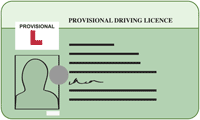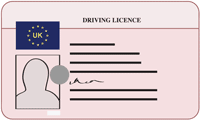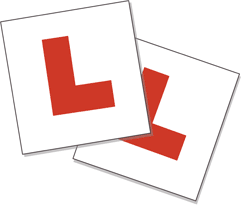The Law
Before you take a learner driver out, it is essential that both you and the learner meet all of the legal requirements, including licensing and insurance rules.
It is illegal to receive any payment for accompanying a learner driver, unless you are an Approved Driving Instructor and hold the ADI certificate from the Driver and Vehicle Standards Agency.
When you are supervising a learner driver, you have the same legal responsibilities as if you were driving. For example, the drink drive laws and the ban on using mobile phone apply to anyone who is supervising a learner - you are deemed to be in control of the vehicle.
Learner Driver
The Learner Driver must:
- Be at least 17 years old
- Have a valid provisional driving licence (for the type of vehicle being used - manual or automatic)
- Be insured to drive the vehicle
- Ensure the vehicle is in a safe and legal condition
- Meet the legal minimum eyesight standards
- Only drive when supervised by a person who is at least 21 years old and has a valid driving licence, which they have held for at least three years
- Put L Plates (or D Plates in Wales) on the front and rear of their vehicle.

Provisional Driving Licence
The learner can apply for a provisional licence online or by completing the D1 form (DL1 form in Northern Ireland) which is available in your local post office.
Do not use an unofficial website to apply for your licence, as you may pay more than necessary, and your application might not even be submitted.
They must have physically received their licence before driving on the road. Once they have received it they can drive a car on the road (but not on motorways) under supervision and while displaying L Plates (or D Plates in Wales).
Insurance
The learner driver must be insured to drive the vehicle. Make sure the insurers know the learner's age and that they are a learner driver.
Eyesight
All drivers must meet the minimum eyesight standard for driving.
In good daylight, drivers must be able to read a vehicle numberplate, made after 1 September 2001, from 20 metres. If the learner needs glasses or contact lenses to read the numberplate, they must wear them whenever they drive.
Drivers must also have an adequate field of vision and a visual acuity of at least decimal 0.5 (6/12) on the Snellen scale (with glasses or contact lenses, if necessary), using both eyes together or, one eye only if the driver only has sight in one eye.
The best way to ensure that you meet the minimum eyesight standard for driving is to have an eyesight test at an opticians before starting to learn to drive (and then every two years, or more often if the optician advises).
Further details about the eyesight rules for driving are available at Eyesight Rules.
The Superviser
The Supervising Driver must:
- Be at least 21 years old
- Have a full driving licence (for the type of vehicle being used - manual or automatic)
- Have held that valid licence for a minimum of three years
- Ensure the car is in a safe and legal condition
- Meet the minimum eyesight standards
- Ensure the car displays L Plates (or D Plates in Wales) when a learner is driving
- Not receive any payment for supervising the learner (unless they are an Approved Driving Instructor)
- Comply with road traffic laws, such as not drinking and driving or using a hand-held mobile phone, even though they are in the passenger seat
Age of the Supervising Driver
Anyone who is supervising a learner driver must be at least 21 years old. This is so they are likely to have sufficient driving experience, and significantly more than the learner.

Driving Licence of the Supervising Driver
The law also requires that the supervising driver has held their full driving licence for at least three years. This prevents someone who has only just passed their Test, and so not had time to gain sufficient driving experience, from supervising a learner.
If the supervising driver has ever been disqualified from driving, the period of the disqualification does not count towards the three year requirement, because the licence was not valid while they were disqualified.
Example One: if you gained your full licence 3 years ago, but were disqualified for 6 months at some point during the last 3 years, you will only have had a valid licence for 2 years and 6 months. In this case, you cannot yet supervise a learner driver.
Example Two: if you gained your full licence 10 years ago, but were disqualified for 6 months at some point during the last 10 years, you will have had a valid licence for 9 years and 6 months. In this case, you can supervise a learner driver.
Insurance
Make sure the learner driver is insured to drive the vehicle they are using for private practice.
Vehicle Owned by the Supervising Driver
If the vehicle is owned by the supervising driver or by another person, make sure that the motor insurance policy includes the learner. Take note of any restrictions. For example, some insurance companies require the supervising driver to be over 25 years old.
Vehicle Owned by the Learner
If the vehicle is owned by the learner, the supervising driver will usually be covered on the learner driver's own insurance and, therefore, does not have to be insured separately. However, check the details before starting to supervise the learner, and whether the insurer has set any restrictions, such as requiring the supervising driver to be over 25 years old.
Eyesight
All drivers must meet the minimum eyesight standard for driving.
In good daylight, drivers must be able to read a vehicle numberplate, made after 1 September 2001, from 20 metres. If the learner needs glasses or contact lenses to read the numberplate, they must wear them whenever they drive.
Drivers must also have an adequate field of vision and a visual acuity of at least decimal 0.5 (6/12) on the Snellen scale (with glasses or contact lenses, if necessary), using both eyes together or, one eye only if the driver only has sight in one eye.
The best way to ensure that you meet the minimum eyesight standard for driving is to have an eyesight test at an opticians before starting to learn to drive (and then every two years, or more often if the optician advises).
Further details about the eyesight rules for driving are available at Eyesight Rules.

The Car
Ensure that the car is in a safe and legal condition, including being properly registered, taxed and MOT'd. It is a good idea to have it checked and serviced before starting private practice.
You must also ensure that L Plates (or D Plates in Wales) are displayed on the front and rear of the vehicle whenever the learner is driving. Remember to remove them after each practice drive.
Pre-Drive Checks
Do a pre-drive check, with your learner, before practice drives, so that they know how to keep the car in a safe and legal condition, and get them into the habit of doing regular checks. The learner will be asked to demonstrate this knowledge as part of their driving test.

Check:
- Tyres are undamaged (no cuts or bulges), are at the correct pressure and have enough tread depth. The legal minimum is 1.6mm, but above 3mm gives much shorter braking distances in the wet
- There are no signs of vehicle damage
- Oil, coolant and windscreen wash levels are correct (check when cold)
- You know the correct type of fuel for the vehicle
- Brakes are working
- Lights and indicators are working
- Windscreen and windows are not damaged
- Washers and wipers are working
- Mirrors are correctly positioned
If you're not sure how to do these checks, read the vehicle's handbook, and/or ask someone to show you. A short film showing how to do simple vehicle checks is available at www.youtube.com/watch?v=h7FaGk30buI.
